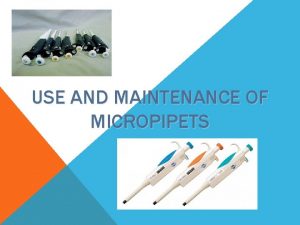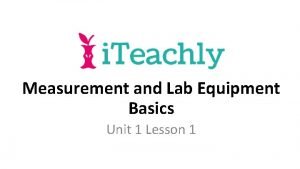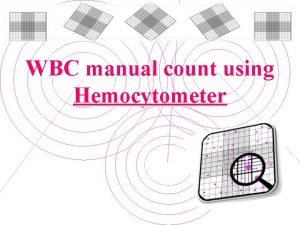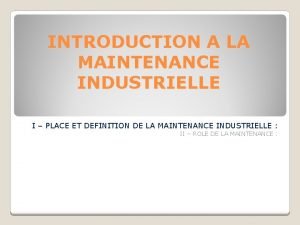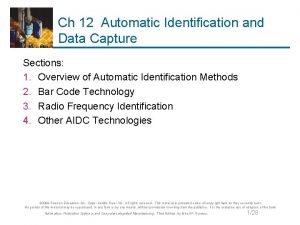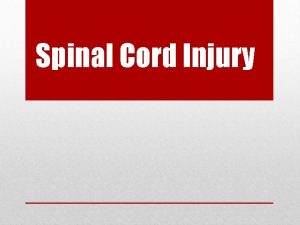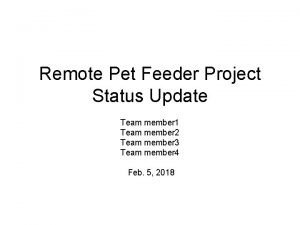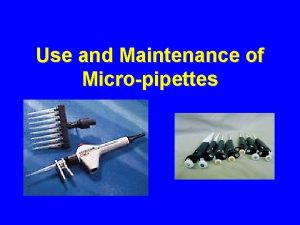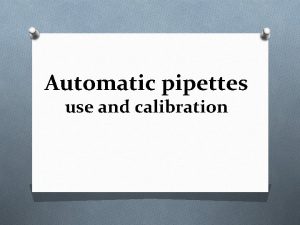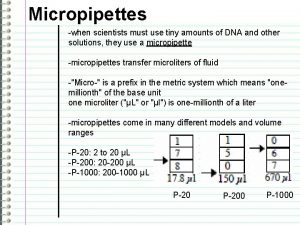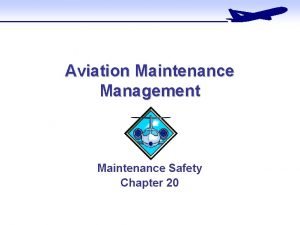Use and Maintenance of Micropipettes Introduction Automatic pipettes














- Slides: 14

Use and Maintenance of Micro-pipettes

Introduction • Automatic pipettes are used to accurately transfer small liquid volumes • Glass pipettes are not highly accurate for volumes less than 1 milliliter (1 ml), but the automatic pipettes are both accurate and precise • These are continuously adjustable digital pipettes • Each pipette can be set to transfer any volume within its own volume range

The Automatic Pipette After successful completion of this module the participant will be able to perform following: • Select the proper automatic pipette to transfer a specified volume of sample • Set a specified volume on the pipette volume indicator using the volume adjustment knob • Read a digital volume setting in both micro liter (µl) and milliliter (ml) units • Demonstrate the correct technique to accurately transfer a sample of a stock solution to another vessel • Correctly answer questions based on the material for the Automatic Pipette

Parts of the Pipette tips

Operating the Micropipette Step 1: Set the Volume Pipettors with 3 Volumes Digital Volume Indicator Volume Adjustment Knob

Operating the Micropipette Step 1: (Continued) Read the Volume How to Read the Volume Indicator: (a): P-20 Model 6. 86 m l = 0. 00686 or 6. 86 x 10 -3 ml (b): P-200 Model (c): P-1000 Model 132. 4 m l = 0. 1324 262 m l= 0. 262 or 1. 324 x 10 -1 ml or 2. 62 x 10 -1 ml

Operating the Micropipette Step 2: Attach the Disposable Tip Example of tip sizes: Attaching the disposable tip

Operating the Micropipette Step 3: Depress the Plunger to the First Stop Step 4: Immerse Tip in Sample Step 5: Draw up the sample Step 6: Pause To aspirate the sample into the tip, allow the pushbutton to return slowly and smoothly to the fully extended UP POSITION NEVER LET THE PLUNGER SNAP UP! This draws the exact calibrated volume into the tip if the tip remains below the liquid surface during withdrawal Wait a few seconds to ensure that the full volume of sample is drawn into the plastic tip WAIT LONGER FOR LARGER VOLUMES. WAIT LONGER FOR MORE VISCOUS ("SYRUP-LIKE") SUBSTANCES

Operating the Micropipette Step 7: Withdraw the Tip Remove the tip from the sample liquid. No liquid should remain on the OUTSIDE of the tip. Wipe away any droplets on the outside of the tip with a lint-free tissue, such as KIMWIPES, but only wipe droplets from the side of the tip NEVER TOUCH THE TIP OPENING or you may absorb part of your sample Proper Droplet Removal WRONG Droplet Removal

Operating the Micropipette Step 8: Dispense the Sample To dispense the sample from the pipette: a) Touch the tip end to the side wall of the receiving vessel b) Depress the plunger to the FIRST STOP c) Pause for at least one second-- 1 -2 seconds for P-1000, 2 -3 seconds for P-5000, or longer for viscous liquids d) Press the plunger to the SECOND STOP (the second point, of greater resistance, at the bottom of the stroke) to expel any residual liquid in the tip (like "blowing out" a glass pipette) (a) Start Dispensing (b) 1 st Stop = Dispense (c) 2 nd Stop = Expel

Operating the Micropipette Step 9: Withdraw the Pipette With the plunger fully depressed, withdraw the pipette from the receiving vessel carefully, sliding the tip along the wall of the vessel. Holding the tip against the side of vessel is especially important when transferring small volumes of liquid Step 11: Discard the Tip Discard the tip by depressing the tip ejector button, as shown below. A fresh tip should be used for each sample to prevent sample carryover Step 10: Release the Plunger Gently allow the plunger to return to the UP position DO NOT allow it to SPRING BACK! Press ejector button to discard tip

Practice with Pipette • Review material and practice using a pipette • Use proper pipetting techniques

Equipment and Supplies • 3 automatic pipettes • Several capped sample vials • Green sample solution to practice volume transfer

Step-wise Operation of the Automatic Pipette (1) Set the volume (2) Attach disposable tip (3) Depress the plunger to the first stop (4) Immerse tip in sample (5) Draw up the sample (6) Pause (7) Withdraw the tip (8) Dispense the sample (9) Withdraw the pipette (10) Release plunger (11) Discard the tip
 Automatic delivery pipette
Automatic delivery pipette P-20 micropipette
P-20 micropipette Meniscus lab equipment
Meniscus lab equipment Hemocytometer procedure
Hemocytometer procedure Introduction sur la maintenance
Introduction sur la maintenance Trey burkett
Trey burkett Difference between input and output device
Difference between input and output device Automatic identification and data capture pdf
Automatic identification and data capture pdf How you use ict today and how you will use it tomorrow
How you use ict today and how you will use it tomorrow Role of nurse in maintaining records and reports
Role of nurse in maintaining records and reports Octopus automatic release creation
Octopus automatic release creation Automatic bladder vs autonomic bladder
Automatic bladder vs autonomic bladder Automatic pet feeder project report
Automatic pet feeder project report Automatic input device
Automatic input device Randoop automatic test
Randoop automatic test
